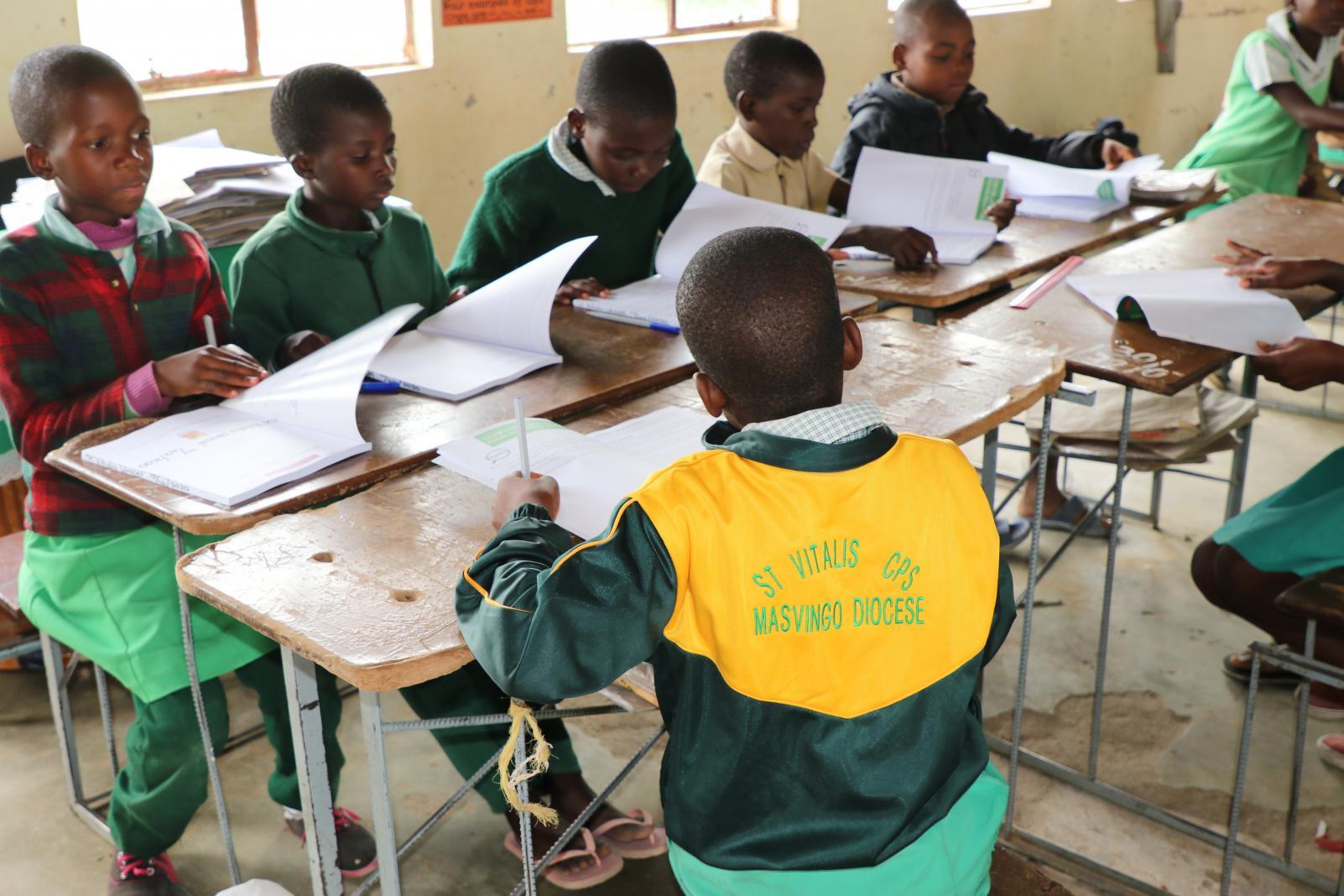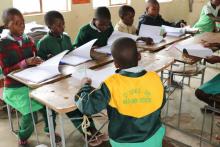Children’s continued learning and welfare should be at the centre of decisions around school re-open

By Alex Gasasira, Laylee Moshiri, and Hubert Gijzen
On any normal weekday morning we would hear the familiar and comforting sounds of school children walking in small groups giggling with each other – strolling down the various roads and footpaths of Zimbabwe’s cities, towns and villages filtering towards the local school. A full day of learning ahead. Wisdom passed on from the teacher. Games or a kick of the football in the school yard. And a good meal for lunch.
But this year that sound and sight has vanished. At end of March, 9500 schools in Zimbabwe were closed due to the COVID-19 pandemic – affecting more than 4.6 million children in the country.
But the Government, through the Ministry of Primary and Secondary Education (MoPSE) and partners such as UNICEF, WHO and UNESCO are working hard to prepare the country towards reopening schools and reopen in the safest way possible for children, teachers and communities.
We are very happy to see that this week Cambridge Examination classes went back to the classroom and the Zimbabwe School Examination Council (ZIMSEC) exam classes: Grade 7, Form 4 and Form 6 will return later in September. We hope all grades will follow soon after that.
While welcoming the steps towards reopening schools, it is worth reinforcing some of the things we know about COVID-19 and the increasing evidence pointing to the impact of school closures on learners.
Scientific evidence tells us that children and adolescents are less likely to contract COVID 19 and when they do, they generally have a milder form of the virus. Documented transmission amongst children and staff within educational settings is limited because so many countries closed schools and children have largely remained at home during times of intense community transmission.
Prolonged closure of schools is not an option in a developing country context given that schooling is protective, particularly for poor and vulnerable children and adolescents. Prolonged school closures negatively impact a child’s ability to learn, including those in pre-primary grades. This can also lead to permanent loss of learning and based on World Bank modelling, school closures in sub-Saharan Africa could result in lifetime earnings losses of $4,500 per child.
The longer children are out of school, the higher their chance of permanently dropping out of school and their likelihood in facing dire problems including child labour. After extended breaks from school many children simply never return.
In equal measure, evidence shows that the cost of a continued lockdown is very high for children. It increases the risk of teenage pregnancies, sexual exploitation, child marriages, abuse, violence, mental health issues and other threats to their well-being.
A framework for reopening schools developed by UNESCO, the World bank, UNICEF and WFP reiterates that these negative impacts will be significantly higher for marginalized children, such as those living in countries affected by conflict and other protracted crises, migrants, the forcibly displaced, minorities, children with disabilities, and children in institutions.
In Zimbabwe, Helpline services such as those operated by Musasa Project and Childline have reported significant increases in reports of gender-based violence and child protection concerns since the lockdown began in April this year. Of the child protection cases reported, many are directly related to violence against children and sexual and gender-based violence, with a majority of the perpetrators being people within the child’s home and close environment.
Further, lengthy closures disrupt essential school-based services such as school feeding which provides the only nutritious meal for many poor children, psychosocial support, immunizations, and can lead to increased anxiety due to loss of teachers/peer interaction.
Without timely action for reopening and increased investment, a learning crisis could turn into a protracted emergency for children’s education and well-being. The message is clear: As lockdown measures and restrictions ease, we need to reopen the classrooms.
So, the big question is: How and when to reopen during this time?
MoPSE in collaboration with other key partners in the Education Working Group has developed a strategy as part of its preparedness and response plan. The key intention is to protect children and teachers when schools re-open, while ensuring quality learning.
This strategy is holistic and proposes measures that can contribute to limit exposure to COVID-19 (and many other diseases at the same time) and reduce the probability of its transmission amongst learners, teachers and school communities, while suggesting ways to build back better and safer school environments.
One of the key objectives includes support to learners, teachers, and school communities to prevent the transmission and spread of COVID-19 and to facilitate safe return to school as schools start re-opening. We are seeing this through sustained planning and investment such as the development of Standard Operating Procedures and new monitoring systems with data from schools to foster quicker and more insightful decision making. Additionally, efforts are being made through rigorous planning and the roll out of personal protective equipment including hygiene kits and reusable masks for teachers, and rehabilitation of water sources in schools.
The strategy also aims at ensuring continuity of quality learning and the well-being of learners, teachers, and school communities during the emergency. We are seeing this through the delivery of 180,000 early childhood development (ECD) books for home learning and development of over 500 primary level radio lessons – broadcast daily throughout the country, as well as a teacher’s resource platform and plan to provide capacity building programmes on distance learning for teachers.
The justification for school re-opening is echoed in the recently issued ‘’Considerations for school-related public health measures in the context of COVID-19’’, published by WHO, UNICEF and UNESCO which is intended to help policy makers and educators with making decisions on running schools as safely as possible during the COVID-19 pandemic, guided by a risk-based approach.
This guidance emphasizes that at the forefront of all considerations and decisions should be the continuity of education for children for their overall well-being, health and safety and maintains that the shutting down of educational facilities should only be considered when there are no other alternatives.
This global health crisis further underscores that teachers are the backbone of every education system and are in actual fact frontline workers. Teachers and school leaders were forced to adapt quickly, and often without preparation, to remote learning modalities. Despite the challenges, the crisis allowed for creativity and innovation in teaching and learning that must be capitalized upon and sustained.
As schools reopen, it will be critical to provide stronger support to teachers, including through continuing professional development, in particular in the area of information and communications technology (ICT) to place more attention on their social and emotional well-being, and ensure social dialogue to protect their rights and ensure they are actively engaged in shaping the educational recovery.
As we move into this new normal of COVID-19, we urge leaders, communities, parents, and teachers to employ the same agility and urgency to safely reopen schools as has been used to open up other parts of society and the economy. Ongoing efforts to minimize the risk of COVID-19 transmission within schools, school associated settings and the wider community are commendable and should be sustained.
The long-term impact of extending the school lockdown risks ever greater harm to children, their future and their communities. Let’s all reimagine learning so that every child gains the skills they need to reach their full potential.
Alex Gasasira is the Representative, WHO Zimbabwe
Laylee Moshiri is the Representative, UNICEF Zimbabwe
Hubert Gijzen is Southern Africa Regional Director and Representative, UNESCO
Communications Officer
Tel: + 263 914 31408
Email: juliasw [at] who.int



